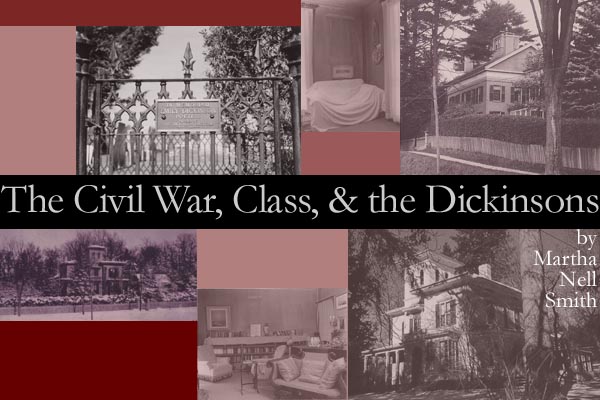
When Virginia Dickinson Reynolds, granddaughter of Samuel Fowler Dickinson Jr., Emily Dickinson's uncle, reconnected with the Amherst branch of her family, Martha Dickinson Bianchi and she found they had much in common. The two Dickinson descendants began corresponding in 1924, and in their earliest exchanges, Virginia tells her cousin about dining with Elinor Wylie [1] and Carl Van Vechten [2], and how they and many other literati admired Bianchi's work on her famous Aunt Emily Dickinson. By the time of the memorial mid-1940s essay reproduced in this site, Reynolds and Bianchi had enjoyed a couple of decades of devoted friendship, often seeing one another or sharing their experiences as part of the intercontinental social elite [3]. They both traveled extensively and frequently, and letters exchanged between them are often postmarked and/or addressed to New York, Paris, Firenze, London, Venezia, Vienna, or some other cosmopolitan center.
In her "Clad in Victory," Virginia Dickinson Reynolds reveals that both her father, Loren, and grandfather, Emily Dickinson's uncle Samuel Fowler Dickinson Jr., Emily's father Edward's youngest brother, "espoused the cause of the Secessionists" in the War between the States and that her father fought for the Confederacy. According to her, "the passionate strain in the Dickinsons which produced the white heat of Puritanical virtues in New England, made of my father an enthusiastic and unreconstructed 'rebel' in the Confederate States." In this statement, she highlights the fact that this upper-class family felt acutely a sense of social responsibility, at least in the mid-nineteenth century. The members went their separate ways in the earlier part of the nineteenth century, the sons of Samuel Fowler Dickinson Sr. forced to recoup the fortune he had squandered on public works, most famously Amherst College. The sense of social responsibility that had bankrupted one generation led Emily Dickinson's father to serve in Congress and the Massachusetts Legislature, and his brother to argue for and nephew to fight for the Confederacy. Though readers might be surprised by this fact, to be against slavery was not necessarily to be an abolitionist, and the Dickinsons who were Southern landed gentry perhaps had more in common with the conservative Whig Edward Dickinson than has previously been explored (Reynolds' comment about her "great uncles... advertising a reward for my father's capture, alive or dead,'" notwithstanding).
• What are the implications of class status for understanding the Dickinsons' various political stances and social assumptions? Edward Dickinson was responsible for bringing two mail deliveries per day to Amherst (Leyda, YH 2:32) and was instrumental in bringing the railroad to Western Massachusetts. These facts of his life tell us something about class status and power and are worth taking into account when analyzing the Dickinsons' political positions.
• What's significant, e.g., about Austin Dickinson paying $500 so that a poor Irishman would serve in his stead for the Union cause while his Georgia cousin, just as wealthy or wealthier than the Amherst Dickinsons, actually fought for the Confederate cause?
• Do Emily Dickinson's poetic responses to the Civil War extend beyond her poems appearing in Union publications to raise money for the Sanitary Commission? E.g., does the manuscript book, or fascicle 24 (R. W. Franklin's numbering), constitute extended poetic reflections on the bitter conflict?
• What about class status and attitudes toward war? What are the various roles of geography, of the location of the war, of territory? If the Amherst Dickinsons are somewhat "southern" in that they are landed gentry, then what begins to account for the differences in their responses to the Civil War?
Notes
[1] Born September 7, 1885, in Somerville, New Jersey, Elinor Wylie published several books of poetry, some novels, and many short stories before her death on December 15, 1928. Part of the New York literary scene, she was recognized for her keen intellect and poetic technique.
[2] Born June 17, 1880, in Cedar Rapids, Iowa, Carl Van Vechten attended teh University of Chicago at the turn of the century. First American critic of modern dance, Van Vechten is perhaps best known for his photography (of artistic and literary figures such as Bessie Smith, Langston Hughes, F. Scott Fitzgerald) and for his enthusiastic promotion of black artists and writers. A frequent visitor to Harlem, his conroversial novel Nigger Heaven was published in 1926.
[3] Throughout their correspondence, one encounters repeated casual allusions such as the following, written by Virginia in a letter to Martha, on September 6, 1939:
We sailed under Admiralty orders and could send no messages, and I am sorry to say that the only person who disobeyed orders was Cornelius Vanderbilt Jr. who was discovered sending messages to the Press from a private radio. His radio was impounded by the Captain. He would have endangered our lives had war been declared a little earlier. . . .



